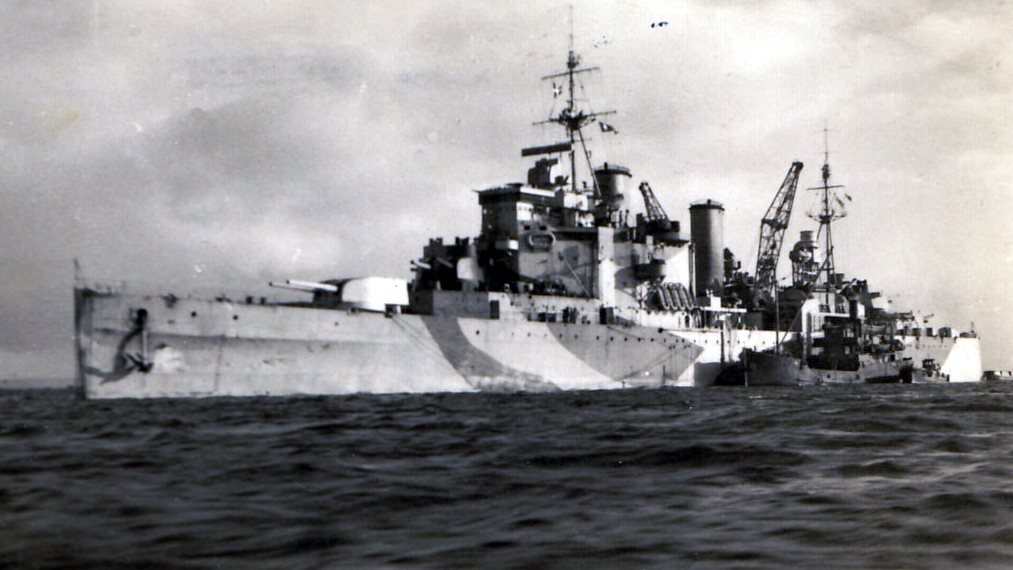British Heavy Cruiser HMS London (1929)
HMS London was a British heavy cruiser of the Royal Navy, the name ship of the London sub-class of the County-class cruisers. She was laid down at Portsmouth Dockyard in February 1926, launched in September 1927, and commissioned in January 1929. The County-class cruisers had been authorised under the terms of the Washington Naval Treaty of 1922, which limited the displacement of cruisers to 10,000 tons and their guns to 8 inches. London and her sisters were designed to meet those restrictions while still carrying a powerful armament and having the range needed to operate across the far-flung stations of the Royal Navy.
As completed, London displaced just under 10,000 tons and carried eight 8-inch guns in four twin turrets, a secondary battery of 4-inch anti-aircraft guns, and multiple lighter weapons. She was powered by Parsons geared turbines driving four shafts, giving a speed of 32 knots and the endurance to serve on overseas stations. Her appearance was dominated by a large bridge structure and tall funnels, typical of the class.
During the interwar years, London spent much of her time on the China Station, where the Royal Navy maintained a strong presence to protect British interests in the region. She was modernised in 1939–41, the most extensive reconstruction of any County-class cruiser. This refit involved replacing her superstructure with a massive blockhouse-style bridge, improving armour protection, and greatly enhancing her anti-aircraft armament. However, the reconstruction increased her top weight, making her heavier and less stable, which earned some criticism.
In the Second World War, London was heavily engaged in convoy escort and fleet operations. Early in the conflict she patrolled in the South Atlantic and Indian Ocean, later returning to home waters. She was part of the forces hunting German surface raiders and blockade runners, and in 1941 she played a role in operations against the German battleship Bismarck, although she did not directly engage in the final battle. Later she served in Arctic convoy duty, escorting the vital supply runs to the Soviet Union, a task that exposed her to extreme weather and persistent German air and submarine attacks.
In 1944, London was transferred to the Eastern Fleet in the Indian Ocean. She remained in the Far East until the end of the war, supporting Allied operations against Japanese positions and protecting shipping lanes.
After the war, London continued in front-line service during the late 1940s. She was present during the Chinese Civil War in 1949 and played a role in the Amethyst Incident on the Yangtze River. HMS Amethyst, a British frigate, had been trapped by Communist Chinese forces after coming under heavy fire. London was ordered to assist in freeing Amethyst but came under intense shore-based artillery fire while steaming up the Yangtze. She was repeatedly hit by shells, suffering severe damage and casualties among her crew. Despite this, London managed to extricate herself, though the mission was unsuccessful and Amethyst remained trapped until her eventual breakout. The action demonstrated the vulnerability of heavy cruisers when confined to restricted waters against well-prepared shore batteries.
Following these events, London was considered worn out from her long service and too costly to overhaul and man. She was decommissioned in 1950 and broken up for scrap the same year.
Specifications of HMS London (as built)
- Class: County-class (London sub-class) heavy cruiser
- Displacement: 9,850 tons (standard), 13,315 tons (deep load, after modernisation)
- Length: 630 ft (192 m)
- Beam: 68 ft 3 in (20.8 m)
- Draught: 21 ft (6.4 m)
- Propulsion: 4 × Parsons geared steam turbines, 8 boilers, 4 shafts, 80,000 shp
- Speed: 32 knots
- Range: 13,300 nautical miles at 12 knots
- Complement: about 700 officers and men (rising to over 800 after refit)
- Armament (as built):
- 8 × 8-inch (203 mm) guns in 4 twin turrets
- 4 × 4-inch (102 mm) anti-aircraft guns
- 4 × 2-pounder (40 mm) pom-poms
- 8 × 21-inch torpedo tubes
- Aircraft: 2 × floatplanes, 1 catapult
- Armour:
- Belt: 1 to 4.5 inches
- Deck: 1.25 inches
- Turrets: 1 inch
- Conning tower: 1 inch




































